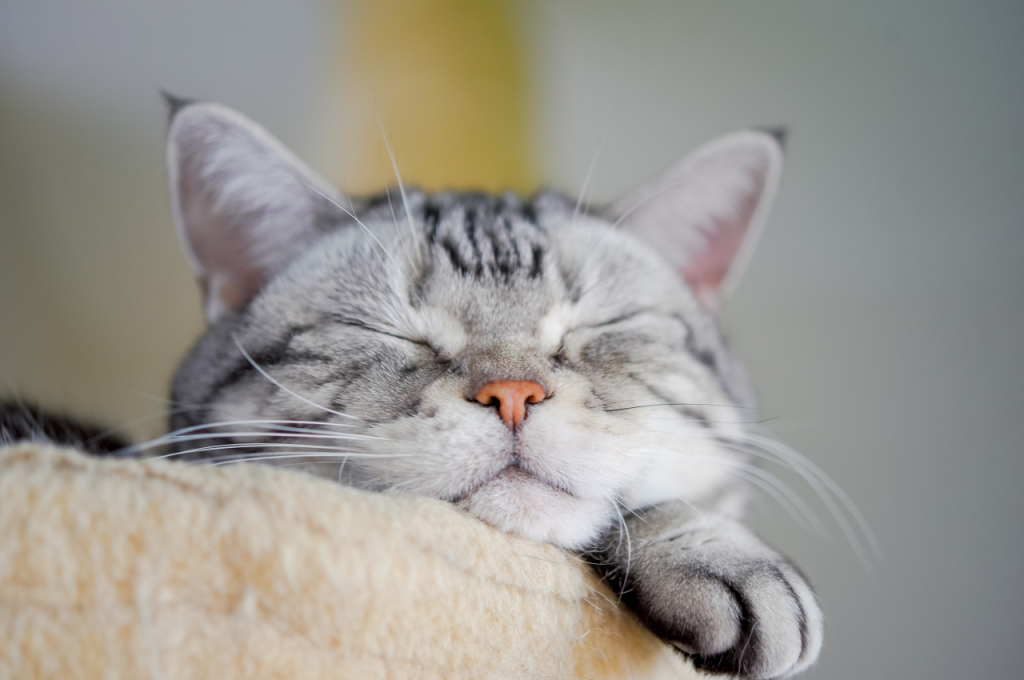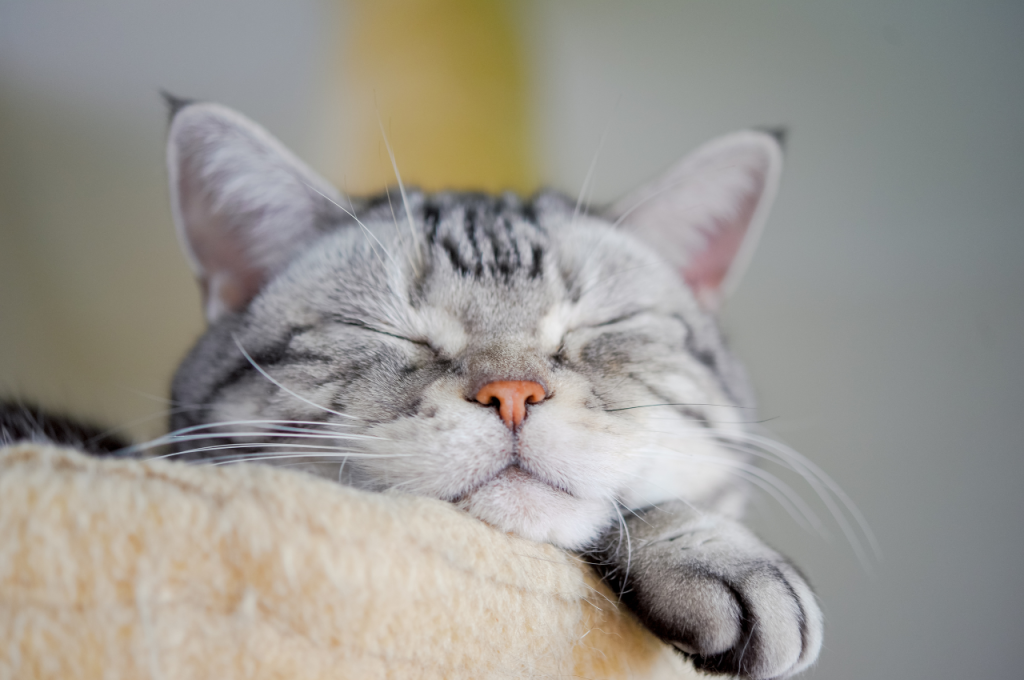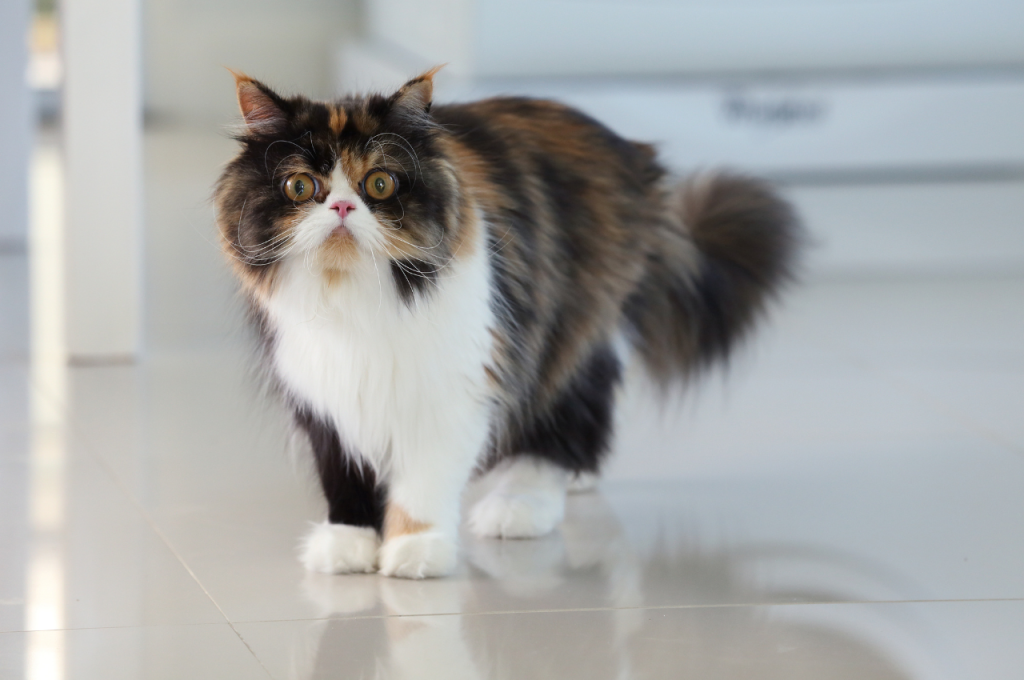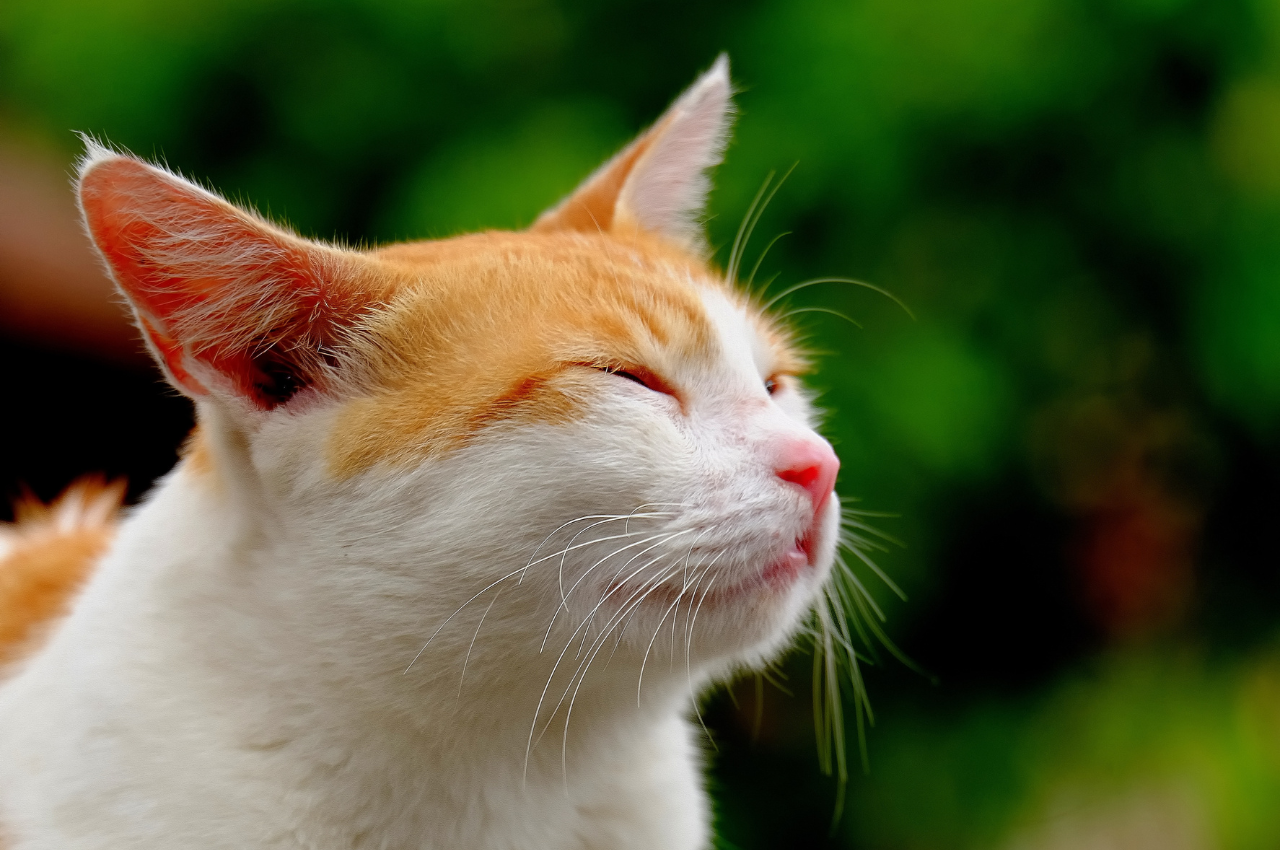A suitable environment for a cat consists of a clean, comfortable space with opportunities for stimulation and relaxation. It should provide access to fresh water, a litter box, and appropriate hiding spots.
The area should be safe and free from hazards such as toxic plants or dangerous objects. Adequate space for exercise and play is important, along with vertical elements like scratching posts or climbing trees. Cats also benefit from access to natural light and windows for observation. Creating a calm and peaceful atmosphere with minimal stressors is essential for a cat’s well-being. By meeting these criteria, you can ensure that your feline companion has a suitable environment to thrive in.
Introduction to Feline Comfort
Cats, being independent creatures, require an environment that meets their physical and psychological needs to thrive. By understanding and providing for their basic needs and ensuring a proper habitat, you can create an ideal setting for your feline companion.

Cats’ Basic Needs
Cats have specific needs that must be met to ensure their comfort and well-being. These include food, water, shelter, play, and rest. Providing a balanced diet, access to clean water, a cozy resting place, and engaging toys are essential for their physical and mental health.
Importance of a Proper Habitat
A suitable habitat is crucial for a cat’s overall well-being. A proper habitat consists of a safe and secure living space that includes areas for exploration, scratching, climbing, and hiding. An enriched environment encourages natural behaviors, reduces stress, and promotes a sense of security for your feline companion.
Safe Spaces in The Home
Create a safe space for your cat by providing cozy hiding spots, elevated perches, and scratching posts. Ensure a quiet environment with easy access to food, water, and litter boxes. Avoid crowded areas and loud noises to help your feline friend feel secure and comfortable at home. Safe Spaces in the Home Creating safe spaces within the home is essential for ensuring your cat feels secure and comfortable. Hiding spots, high perches, and exclusive areas are crucial for a cat’s well-being. Providing these spaces allows your feline friend to exhibit natural behaviors and reduce stress.
Hiding Spots
Cats often seek out hiding spots when they feel overwhelmed or anxious. Offer options such as cardboard boxes, cozy nooks, or covered beds. These spaces give them a sense of security and privacy, promoting a calm and contented demeanor.
High Perches
Cats love to perch up high to observe their surroundings. Providing high perches like cat trees, shelves, or window perches allows them to feel safe while surveying their territory. This also satisfies their natural instinct to climb and explore, promoting physical activity and mental stimulation.
Exclusive Areas
Cats appreciate having areas they can claim as their own. Consider setting up exclusive areas such as cat shelves, secluded corners, or designated furniture where they can retreat and relax undisturbed. These spaces provide a sense of ownership and control, reducing potential territorial issues. By incorporating these safe spaces in your home, you can contribute to your cat’s overall well-being and contentment.
Comfortable Resting Areas
Creating a comfortable resting area for your cat is essential for their well-being and happiness. Cats love to relax and snooze in cozy spots, so it’s important to provide them with suitable resting areas that cater to their needs. Here’s how you can ensure your feline friend has the perfect place to unwind.
Beds and Blankets
Selecting the right bed and blanket for your cat is crucial. Look for a bed that offers adequate support and comfort, preferably with a soft, cushioned surface. Ensure that it’s large enough for your cat to stretch out and move around comfortably. Incorporate blankets or throws that are soft and easy to clean, providing an extra layer of warmth and comfort for your cat.
Temperature Control
Maintaining a comfortable temperature in your cat’s resting area is important. Ensure that the room is neither too hot nor too cold. In colder months, consider using a heated bed or pad to keep your cat warm and cozy. In warmer weather, provide access to cool, shaded areas where your cat can relax comfortably.
Quiet Zones
Creating quiet zones in the house is essential for your cat’s peace and relaxation. Designate a peaceful area where your cat can retreat to when they need some downtime. Consider placing their bed in a secluded spot, away from high-traffic areas and loud noises, allowing them to rest undisturbed.
Play and Stimulation
Cats thrive in a suitable environment that provides ample play and stimulation. A good environment includes interactive toys, scratching posts, and climbing structures to keep them active and engaged. Creating a stimulating space for your cat can enhance their overall well-being and happiness.
Toys and Entertainment
Toys and entertainment play a crucial role in creating a suitable environment for a cat. Providing a variety of toys, such as interactive puzzles, feather wands, and laser pointers, helps stimulate your cat mentally and physically. A well-designed environment should include safe spaces for climbing and exploring, like cat trees and shelves, as well as cozy spots for resting. Engaging in regular playtime with your cat reduces boredom and prevents behavioral issues. Ensuring your cat has a stimulating and enriching environment supports their overall well-being and happiness.
Interactive Playtime
Interactive playtime is essential for a cat’s physical and mental well-being. A suitable environment for a cat includes spaces that stimulate their natural instincts and provide opportunities for exercise and engagement. This means incorporating elements like climbing structures, scratching posts, and interactive toys into their living space. Providing varied play experiences such as puzzle toys, wand toys, and laser pointers keeps cats mentally sharp and helps prevent boredom. Additionally, creating a safe, enriching environment with comfortable resting spots and hiding places supports overall health and happiness. By fostering an environment that encourages active play, you can enhance your cat’s quality of life and strengthen your bond with them.
Outdoor Access vs. Indoor Safety
When considering what is a suitable environment for a cat, it’s essential to weigh the benefits and risks of outdoor access versus indoor safety. Outdoor access allows cats to engage in natural behaviors, such as hunting and exploring, which can provide mental and physical stimulation. However, it also exposes them to dangers like traffic, predators, and diseases.
In contrast, indoor environments offer safety from these hazards but require enrichment to keep cats engaged. A well-designed indoor space should include scratching posts, climbing structures, and interactive toys to meet their physical and mental needs. Providing a mix of indoor play and controlled outdoor time, such as leash walks or supervised play in a secure enclosure, can balance their need for safety with their natural instincts.
Feeding and Hydration Stations
Create a suitable environment for your cat with feeding and hydration stations. Cats thrive in a calm, quiet space with access to fresh water and nutritious food. Providing a dedicated area for feeding and drinking can help your cat feel secure and content in their home.
Feeding and Hydration Stations are essential components of a cat’s environment, as they can affect their health and well-being. As a responsible cat owner, you must provide suitable feeding and hydration stations for your feline friend. In this post, we’ll discuss the key factors to consider when setting up a feeding and hydration station for your cat, including the placement of bowls, the type of food, and water source accessibility.
Placement of Bowls
The placement of your cat’s food and water bowls is important to ensure your cat’s comfort and safety. Place the bowls in a quiet, low-traffic area of your home, away from litter boxes, to prevent contamination. Also, avoid placing them near appliances or furniture that may intimidate or startle your cat. Place the food and water bowls at least a foot apart to prevent spilling and keep them away from walls to prevent food and water from getting trapped.
Type of Food
The type of food you provide for your cat is crucial for their overall health and well-being. You can choose from wet, dry, or a combination of both foods depending on your cat’s preferences and dietary needs. Wet food provides more moisture and is ideal for cats who don’t drink enough water. Dry food is convenient and can help maintain your cat’s dental health. Consult with your vet to determine the best type of food for your cat’s specific needs.
Water Source Accessibility
Water is essential for your cat’s health and should be accessible at all times. Provide a clean, fresh, and preferably filtered water source for your cat. The water bowl should be wide and shallow to prevent tipping and placed away from food bowls to prevent contamination. You can also consider providing multiple water sources throughout your home to encourage your cat to drink more water.
In conclusion, setting up suitable feeding and hydration stations for your cat is crucial for their health and wellbeing. By following these tips, you can ensure that your cat is comfortable, safe, and well-nourished.
Litter Box Essentials
Creating a suitable environment for your cat includes providing litter box essentials. Ensure a clean and comfortable space with easy access, appropriate litter material, and regular maintenance. Keep your feline friend happy and healthy with a well-designed litter box area.
Location and Privacy
- Cats prefer quiet areas for their litter box. Place it away from high-traffic spots.
- Provide privacy by placing the litter box in a secluded but accessible location.
Cleanliness
- Scoop the litter box daily and do a full cleaning weekly to keep it fresh.
- Use unscented litter to avoid overwhelming your cat’s sensitive sense of smell.
Type of Litter
- Choose a clumping litter for easier cleaning and to control odors effectively.
- Experiment with different types of litter to find what your cat prefers.
Healthcare and Grooming
Creating a suitable environment for a cat involves ensuring both its healthcare and grooming needs are met. A clean, safe, and stimulating environment promotes overall well-being. Healthcare aspects include regular veterinary check-ups, vaccinations, and addressing any health issues promptly. Grooming is also essential; it helps maintain a healthy coat and skin, reduces shedding, and prevents matting. Providing a comfortable space with scratching posts, cozy bedding, and a balanced diet supports both physical health and emotional comfort.

Additionally, regular grooming routines, such as brushing and nail trimming, contribute to a cat’s happiness and health. By integrating these elements into your cat’s daily routine, you create a supportive environment that fosters a healthy and content feline companion.
Regular Vet Visits
Just like humans, cats also require regular check-ups with a vet to ensure they are healthy. It’s recommended to schedule a visit at least once a year for vaccinations, physical exams, and preventative care. During these visits, the vet can also detect any potential health issues before they become serious problems. It’s important to keep your cat up-to-date with their shots and medications to prevent illnesses and diseases.
Grooming Routines
Grooming is an essential part of a cat’s healthcare routine. It helps maintain their hygiene and prevents hairballs and other issues. Brushing your cat’s fur regularly helps remove loose hair and prevents mats. Trimming their nails every few weeks prevents them from becoming overgrown and causing discomfort. Additionally, cleaning their ears and teeth regularly can prevent infections and dental issues.
Managing Stress and Anxiety
Cats can experience stress and anxiety, just like humans. Common causes of stress in cats include changes in their environment, lack of socialization, and illness. It’s important to create a safe and comfortable environment for your cat to minimize stress. Providing a designated space for them to retreat to and engaging in playtime can help alleviate anxiety. If your cat is exhibiting signs of stress, such as excessive grooming or hiding, it’s important to consult with a vet to determine the underlying cause and develop a plan to manage it.
In conclusion, prioritizing your cat’s healthcare and grooming needs is essential for their overall health and happiness. Regular vet visits, grooming routines, and stress management can help ensure your cat lives a long, healthy, and happy life.
Human-animal Interaction
A suitable environment for a cat includes plenty of vertical space for climbing, hiding spots for privacy, and interactive toys for mental stimulation. Providing scratching posts and cozy resting areas will help create a comfortable and enriching space for your feline friend.
Human-animal interaction is a vital aspect of a cat’s environment. Cats are social creatures and thrive on attention and affection from their human companions. Understanding Cat Behavior is essential for building a strong bond with your feline friend. Respectful Handling is crucial to ensure your cat feels safe and secure in its environment. Bonding Activities help to create a positive atmosphere and strengthen the relationship between you and your cat.
Understanding Cat Behavior
Cats have a unique set of behaviors that differ from other pets. They are independent creatures and may seem aloof, but they also crave attention and affection. Understanding your cat’s body language, vocalizations, and habits is crucial for developing a strong bond. For example, tail movement can indicate a cat’s mood, and purring often signifies contentment.
Respectful Handling
Cats are sensitive animals and can be easily stressed by improper handling. It’s important to approach your cat calmly and gently. Never grab or restrain a cat forcefully as this can cause fear and anxiety. Instead, let your cat come to you and use slow movements to pet them. If your cat seems uncomfortable, give them space and try again later.
Bonding Activities
Bonding Activities can help to create a positive environment for your cat. Activities like playing with toys, grooming, and cuddling can strengthen the bond between you and your feline friend. Regular playtime is essential for a cat’s physical and mental health. It’s also important to provide a safe and comfortable space for your cat to relax and feel secure.
In conclusion, Human-Animal Interaction is a crucial aspect of a cat’s environment. Understanding Cat Behavior, Respectful Handling, and Bonding Activities are all essential for building a strong bond with your cat. By creating a positive and supportive environment, you can ensure that your feline friend is happy, healthy, and thriving.
Common Hazards to Avoid
A suitable environment for a cat should avoid common hazards. It should provide a safe space with no toxic plants, secure windows and balconies, and no access to harmful chemicals or small objects that can be swallowed. Additionally, it should offer hiding spots, scratching posts, and interactive toys to keep the cat mentally stimulated and physically active.
Toxic Plants and Foods
Cat owners must be aware of toxic plants like lilies, poinsettias, and aloe vera. These plants can cause severe digestive issues and even death in cats. Always keep these plants out of reach.
Unsafe Household Items
Common household items like string, rubber bands, and small toys can be choking hazards for cats. Ensure these items are stored away safely to prevent accidents.
Preventing Escapes and Injuries
Secure all windows with sturdy screens to prevent falls and escapes. Keep balconies off-limits to avoid potential injuries. Regularly check for any potential escape routes.
Adapting to Special Needs
A suitable environment for a cat is crucial to their well-being. Providing a comfortable and stimulating space with plenty of hiding spots, scratching posts, and toys can help meet their special needs.
Cats, like humans, have varying needs that change as they age or develop disabilities. As a responsible cat owner, it’s important to create a suitable environment that caters to these special needs. Here are some tips on how to adapt to special needs for senior cats, cats with disabilities, and cats with behavioral challenges.
Senior Cats
As cats age, they may experience physical and cognitive changes that require special attention. Here are some ways to create a suitable environment for senior cats:
- Provide easy access to food and water bowls by placing them at a comfortable height.
- Make sure litter boxes have low entry points to accommodate arthritic joints.
- Offer soft bedding in warm areas to provide comfort for achy joints.
- Ensure that your senior cat has easy access to their favorite spots and provide ramps or steps if necessary.
- Keep up with regular vet visits to catch any health problems early on.
Cats with Disabilities
Cats with disabilities, such as blindness or deafness, require special attention to ensure their safety and comfort. Here are some ways to create a suitable environment for cats with disabilities:
| Disability | Adaptation |
| Blindness | Use scent markers to help your cat navigate around the house. Keep furniture in the same place to prevent confusion and injury. Provide scratching posts and toys with sounds to engage your cat. |
| Deafness | Use visual cues, such as hand signals, to communicate with your cat. Keep your cat indoors to prevent them from getting lost. Provide soft surfaces for your cat to walk on to reduce vibrations. |
| Amputation | Provide low-entry litter boxes and easy access to food and water bowls. Use soft bedding for comfort and provide ramps or steps for easy access to their favorite spots. |
Behavioral Challenges
Cats with behavioral challenges, such as anxiety or aggression, require a calm and stable environment. Here are some ways to create a suitable environment for cats with behavioral challenges:
- Provide a safe and quiet space for your cat to retreat to when feeling anxious or stressed.
- Use pheromone sprays or diffusers to reduce anxiety and promote relaxation.
- Provide plenty of mental and physical stimulation through playtime and puzzle toys.
- Consult with your vet or a certified cat behaviorist for more personalized advice.
Fostering a Thriving Environment
Creating a suitable environment for a cat involves providing enriching spaces with cozy nooks and interactive toys. Ensuring ample sunlight, hiding spots, and vertical spaces promotes their well-being, encouraging natural behaviors and a thriving feline companion.
Continuous Improvement
A suitable environment for a cat involves creating a safe, stimulating, and comfortable space that caters to their physical and emotional needs. Ensure your cat has access to a variety of enrichment activities, such as scratching posts, climbing structures, and interactive toys, to keep them mentally and physically engaged. Provide a cozy and quiet resting area where they can retreat and relax. Maintain a clean litter box and offer fresh water and high-quality food. Additionally, ensure that your home is free of hazards and secure, with windows and balconies protected to prevent accidental falls. Regular interaction and affection from you also contribute to a positive and nurturing environment, supporting your cat’s overall well-being.
Observing Your Cat’s Behavior
Observing your cat’s behavior is key to understanding what constitutes a suitable environment for them. A cat’s environment should include areas for climbing, scratching, and exploring, as these fulfill their natural instincts and provide mental stimulation. Ensure there are cozy resting spots and hiding places where your cat can feel secure and relaxed. Regularly monitor your cat’s behavior for signs of stress or discomfort, such as excessive hiding or aggression, which may indicate environmental issues. By providing a stimulating and comfortable environment, you can enhance your cat’s well-being and ensure they are content and healthy.

Seeking Professional Advice
Creating a suitable environment for a cat involves more than just providing food and shelter. It’s essential to seek professional advice to ensure your cat’s living space is optimal for its physical and emotional well-being. Veterinarians and pet behaviorists can offer guidance on creating a safe and stimulating environment that includes comfortable resting areas, scratching posts, and interactive toys. They can also advise on proper litter box placement and maintenance, as well as the importance of a consistent routine. Additionally, professionals can help address any specific needs your cat might have, whether related to health, behavior, or diet, ensuring a harmonious and enriching living space for your feline friend.
Conclusion
To provide a suitable environment for your cat, focus on creating a safe, stimulating space. Consider their needs for comfort, play, and relaxation. By incorporating scratching posts, cozy beds, and interactive toys, you can ensure a happy and healthy feline companion.
